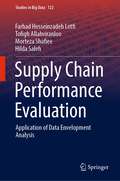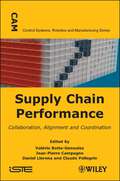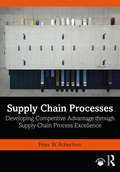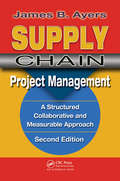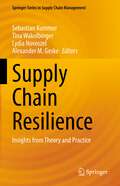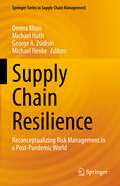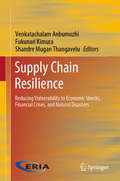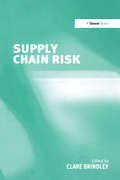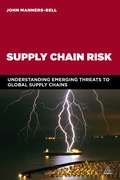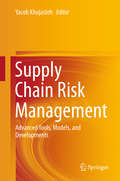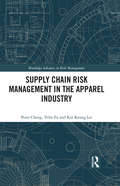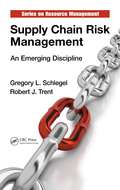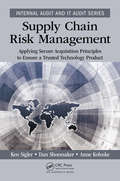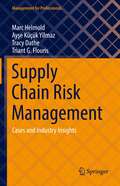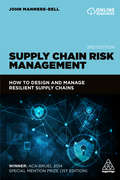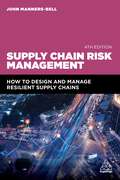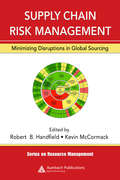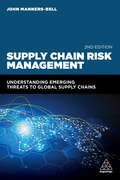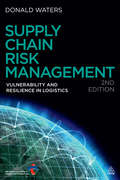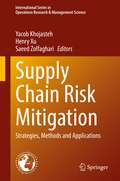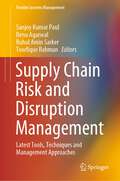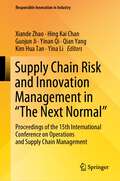- Table View
- List View
Supply Chain Partners: Virginia Mason and Owens & Minor (A) (Abridged)
by V. G. Narayanan Lisa BremOwens & Minor (O&M) performed lean inventory services for Virginia Mason (VM) as its alpha vendor, but the outdated industry pricing model created perverse incentives and could not capture O&M's costs. Together, O&M and VM created an activity-based pricing model called the total supply chain costs (TSCC), which incented both companies to be more efficient and to streamline their distribution activities. After beta testing the TSCC for one year, VM's Daniel Borunda and O&M's Michael Stefanic believed that TSCC was a better and more cost-effective pricing model, but could they convince their companies to continue to invest in TSCC?
Supply Chain Partners: Virginia Mason and Owens & Minor (B)
by V. G. Narayanan Lisa BremThe epilogue to Supply Chain Partners: Virginia Mason and Owens & Minor (A), the B case details the outcome of the issues discussed in Case A; namely that Virginia Mason and Owens & Minor did implement the TSCC contract. Virginia Mason also kept the suture contract with O&M because the TSCC model was able to prove that O&M was the low-cost provider. Case B also gives results metrics, such as reduction in line items, orders, and days sales outstanding.
Supply Chain Performance Evaluation: Application of Data Envelopment Analysis (Studies in Big Data #122)
by Tofigh Allahviranloo Farhad Hosseinzadeh Lotfi Morteza Shafiee Hilda SalehThe authors of this book tried to make these experiences available to those interested, considering the experience of several years of training, research, and implementation of projects in the supply chain performance evaluation field.This book intends to identify the current performance and competitive position of that supply chain compared to other supply chains by presenting and reviewing the techniques and models for measuring the efficiency and performance of the supply chain. Determining the performance of a supply chain is a good description of the status quo (what is). Determining the performance of a supply chain is useful for describing the past and present of supply chain processes, and on the other hand, it can be used to set performance goals and initiate the improvement process. To realize this, a strategic framework or model is needed to be able to extract indicators related to the efficiency of the supply chain and design the appropriate model.
Supply Chain Performance: Collaboration, Alignment and Coordination
by Valérie Botta-Genoulaz Daniel Llerena Claude Pellegrin Jean-Pierre CampagneThis book examines the opportunities for, and the effects and benefits of, collaborative working practices and their impact on supply chain performance. The first part of the book focuses on modeling the supply chain using conceptual frameworks to describe the relationship between collaboration and performance. The second part examines the issues around information systems alignment, and ensuring the management and coordination of interactions with suppliers and customers. The final part focuses on the various different formalized approaches that may be taken to analyze the impact of any given collaboration process, coordination mechanism, or decision-making behavior.
Supply Chain Processes: Developing Competitive Advantage through Supply Chain Process Excellence
by Peter W. RobertsonSupply Chain Processes introduces readers to the view that genuine supply chain competitive advantage is achieved via supply chain excellence which in turn is underpinned by supply chain process excellence. The ultimate supply chain goal is to deliver the right product, of the right quality, in the right quantity, to the right place, at the right time and for the right cost. The author identifies four core supply chain processes – strategy, design, execution and people – to which the process improvement techniques explained can be applied to ensure superior supply chain performance. Key topics are addressed, including supply chain risk, resilience, sustainability, challenges confronting modern-day supply chains and developing an elegant supply chain design. Each chapter starts with a section that explores learning opportunities and is followed by detailed chapter content. Carefully explained examples are provided, as well as end of chapter case studies, review questions and written assignments. A full suite of teaching aids is also provided for lecturers and tutors. Providing both management expertise and technical skills, which are essential to decision-makers in the supply chain, this textbook should be essential reading for undergraduate and post-graduate students, working people or mature aged persons wanting to upgrade their qualifications, and operating supply chain leaders and supply chain professionals. Online resources include chapter-by-chapter PowerPoint slides, tutorial exercises, written assignments and a test bank of exam questions.
Supply Chain Project Management.
by James B. AyersImproving supply chain efficiency, especially in an unsettled business climate, requires that managers go beyond doing business as usual. They must apply inspiration and perspiration in a structured, collaborative, and measurable approach that blends project management with supply chain management knowledge and practice.Supply Chain Project Ma
Supply Chain Resilience: Insights from Theory and Practice (Springer Series in Supply Chain Management #17)
by Sebastian Kummer Tina Wakolbinger Lydia Novoszel Alexander M. GeskeEvery global crisis highlights the strategic importance of industrial and non-profit supply chains for society. In terms of coping with unforeseen and unpredictable events, supply chain resilience enables the parties and networks involved to stay successful during and after the disruption. Furthermore, a resilient supply chain contributes to the sustainable competitive advantage of the entire value chain. Written by scholars and practitioners alike, this book not only puts forward a new framework for resilience in supply chain management, but also presents best practice cases from various areas and industries. As a particular highlight, it includes a Delphi study that gathers state-of-the-art insights from supply chain leaders. In addition to practical approaches, methods and tools, the book also offers food for thought on the future of supply chain resilience. As such, it offers a valuable resource for current and future managers in the public and private sector, as well as researchers and students engaged in this field.
Supply Chain Resilience: Reconceptualizing Risk Management in a Post-Pandemic World (Springer Series in Supply Chain Management #21)
by Michael Huth Omera Khan George A. Zsidisin Michael HenkeThis book provides insights from research and practice in how organizations were able to sustain resilience in their global supply chains during the COVID-19 pandemic and to advance the understanding of supply chain risk management. The chapters highlight the lessons learned, insist on new models for resilience, suggest improved supply chain risk methodologies and bridge the gap between research and practice. It helps readers acquire greater knowledge, strategic approaches, new methods, and practical tools for ensuring global supply chain resilience.
Supply Chain Resilience: Reducing Vulnerability to Economic Shocks, Financial Crises, and Natural Disasters
by Venkatachalam Anbumozhi Fukunari Kimura Shandre Mugan ThangaveluThis book investigates individual companies’ and industries’ supply chain risk management approaches to identify risk drivers and verify effective risk-reduction measures and business continuity plans.Typically, supply chain risk assessments focus on normative guidelines based on single best practice examples or vulnerability events, and there has been little work exploring how the concepts of supply chain risk management and resilience are related. However, since this relationship has implications for developing integrated response strategies, a clear understanding of the possible consequences is a fundamental step in building socio-economic resilience along the supply chain.Against this background, the book addresses three main topics: firstly, it defines the conceptual and sectoral domains of supply chain risk management and resilience by examining the welfare effects of extreme weather events and other economic shocks on selected global supply chains. It then presents an in-depth analysis of the scope of public–private partnerships to tackle the risks, by empirically exploring supply chain risk effects and information management. Thirdly, it proposes a regional cooperation framework in the context of major supply chain vulnerability events such as disasters and global financial crises.
Supply Chain Risk
by Clare BrindleyThe impact of technological change, globalization, information and communication technologies and international governmental intervention has radically altered supply chain strategies, operations and risk profiles for most organizations. The challenge facing business and researchers alike is how best to address risk management in this new context. This collection, written by international scholars from the UK, US and Scandinavia, addresses this need by providing the first topical review of these developments and the latest research findings. The findings represent a robust cross-disciplinary view of supply chains, articulating policies and strategies for organizations. The research studies are based on empirical case studies within services and manufacturing in both large and SME organizations. This work is intended to provide the foundation for future research in this expanding area and the impact it has on managing risk within the supply chain.
Supply Chain Risk
by John Manners-BellSupply Chain Risk assesses the various sources of external threat to the supply chain, including environmental, geopolitical, economic and technological. John Manners-Bell clearly describes the evolving risks to supply chains and how multinational corporations should be dealing with them at a strategic level. He examines the lack of supply visibility which puts businesses at risk and includes case studies of best practice, as well as citing examples of when and how things go wrong. Each case study describes a company's supply chain and production/ sourcing strategy; a description of the catastrophic event which occurred; consequences to supply chain and management response; material losses incurred and resultant changes to company supply chain strategy.
Supply Chain Risk Management
by Yacob KhojastehThis book covers important issues related to managing supply chain risks from various perspectives. Supply chains today are vulnerable to disruptions with a significant impact on firms' business and performance. The aim of supply chain risk management is to identify the potential sources of risks and implement appropriate actions in order to mitigate supply chain disruptions. This book presents a set of models, frameworks, strategies, and analyses that are essential for managing supply chain risks. As a comprehensive collection of the latest research and most recent cutting-edge developments on supply chain risk and its management, the book is structured into three main parts: 1) Supply Chain Risk Management; 2) Supply Chain Vulnerability and Disruptions Management; and 3) Toward a Resilient Supply Chain. Leading academic researchers as well as practitioners have contributed chapters, combining theoretical findings and research results with a practical and contemporary view on how companies can manage the supply chain risks and disruptions, as well as how to create a resilient supply chain. This book can serve as an essential source for students and scholars who are interested in pursuing research or teaching courses in the rapidly growing area of supply chain risk management. It can also provide an interesting and informative read for managers and practitioners who need to deepen their knowledge of effective supply chain risk management.
Supply Chain Risk Management in the Apparel Industry (Routledge Advances in Risk Management)
by Peter Cheng Yelin Fu Kin Keung LaiApparel is one of the oldest and largest export industries in the world. It is also one of the most global industries because most nations produce for the international textile and apparel market. The changing global landscape drives cost volatility, regulatory risk and change in consumer preference. In today’s retail landscape, media and advocacy groups have focussed attention on social and environmental issues, as well as new regulatory requirements and stricter legislations. Understanding and managing any risk within the supply chain, particularly ethical and responsible sourcing, has become increasingly critical. This book first gives a systematic introduction to the evolution of SCRM through literature review and discusses the importance of SCRM in the apparel industry. Second, it describes the life cycle of the apparel supply chain and defines the different roles of the value chain in the apparel industry. Thirdly, it identifies the risk factors in the Apparel Life Cycle and analyses the risk sources and consequences and finally, extends the importance of selection of the suppliers and develops a supplier selection model and SCRM strategies solution by data analysis and case studies.
Supply Chain Risk Management: An Emerging Discipline (Resource Management)
by Gregory L. Schlegel Robert J. TrentYou don�t have to outrun the bear � you just have to outrun the other guy. Often in business we only have to run a bit faster than our competitors to be successful. The same is true in risk management. While we would always like to anticipate and prevent risk from happening, when risk events do occur being faster, flexible, and more responsive than
Supply Chain Risk Management: Applying Secure Acquisition Principles to Ensure a Trusted Technology Product (Internal Audit and IT Audit)
by Dan Shoemaker Anne Kohnke Ken SiglerThe book presents the concepts of ICT supply chain risk management from the perspective of NIST IR 800-161. It covers how to create a verifiable audit-based control structure to ensure comprehensive security for acquired products. It explains how to establish systematic control over the supply chain and how to build auditable trust into the products and services acquired by the organization. It details a capability maturity development process that will install an increasingly competent process and an attendant set of activities and tasks within the technology acquisition process. It defines a complete and correct set of processes, activities, tasks and monitoring and reporting systems.
Supply Chain Risk Management: Cases and Industry Insights (Management for Professionals)
by Marc Helmold Tracy Dathe Triant G. Flouris Ayşe Küçük YılmazThis book provides a holistic and practical approach to managing supply chains risks and presents a new framework model for sustainable optimization of risk management. This framework includes supportive tools for risk mapping and strategic decision-making. Managers can apply tailored versions of this framework for the management process of their respective sector. The authors provide case studies in industries such as automotive, aviation, airport, and healthcare.
Supply Chain Risk Management: How to Design and Manage Resilient Supply Chains
by John Manners-BellFrom political uncertainty to trade disrupts and cyber threats, the risk environment is continuously evolving, and new challenges frequently arise demanding immediate attention to avoid disruption to supply chains. Supply Chain Risk Management is the guide to recognizing, reviewing and reacting to these risks to ensure continued operations and optimal service. This book is a practical learning tool which offers a comprehensive framework to understanding risk and how to engineer resilience into the supply chain. The third edition of Supply Chain Risk Management details how to approach various threats, including black swan events, natural disasters, climate change, cargo crime and piracy, and terrorism and security. Using case studies and recent, topical examples, this book demonstrates how to successfully manage these risks and apply learnings in practice. Objectives, summaries and key point checklists in each chapter also help the reader grasp these key concepts and understand how to keep supply chains resilient. Online resources include lecture slides.
Supply Chain Risk Management: How to Design and Manage Resilient Supply Chains
by John Manners-BellNavigate a continually evolving global risk landscape and react to new logistical challenges effectively with this vital guide on supply chain risk.Implementing robust supply chain strategies has never been so essential in today's everchanging world. From geo-political risks to the continued effects of global crises, Supply Chain Risk Management is an essential resource for those wanting to mitigate risk and ensure supply chain resilience. Offering crucial insight from a management perspective, this updated 4th edition offers new guidance on the effects of the Covid-19 pandemic, supply-chain bottlenecks and evolving geo-political risks.With new global case studies including disruption to the supply chain due to the Suez Canal blockage and global tensions like the US-China trade war, this edition explores a variety of real-world risks. This book details ongoing threats like climate change, corruption and technological risks while providing crucial detail on how to implement robust systems and safeguard supply chain operations. Combining theoretical and practical learning, Supply Chain Risk Management is essential for those needing to understand risk and how it can be approached.
Supply Chain Risk Management: Minimizing Disruptions in Global Sourcing (Resource Management)
by Kevin McCormack Robert B. HandheldThe lifeblood of any business is the timely delivery of products and services. In the best possible world, if one plans accordingly, disruptions never occur. However, in the real world, disruptions do and will occur and the best business plans are those that anticipate and prepare for this inevitability, especially when dealing with international s
Supply Chain Risk Management: Understanding Emerging Threats to Global Supply Chains
by John Manners-BellWith increased outsourcing, globalisation, and just-in-time production, the ability to effectively identify, assess and manage risks in the supply chain is more important than ever. Supply Chain Risk Management is a practical learning resource which explores a wide range of external threats to the supply chain such as natural disasters, economic risk, terrorism and piracy. An ideal companion to academic and professional training courses, it presents a robust set of strategies which can minimise and mitigate supply chain risk.Supply Chain Risk Management includes numerous best practice case studies, with each case documenting the company's supply chain or production strategy and outlining the catastrophic event which occurred. This comprehensive second instalment of Supply Chain Risk, which won the 2014 ACA-Bruel Special Mention prize, analyses the supply chain consequences, material losses, management response, and resultant changes to a company's supply chain strategy. With a new chapter on cyber threats to supply chains, Supply Chain Risk Management also includes academic pedagogy such as objectives, summaries and a key point checklist in each chapter.
Supply Chain Risk Management: Vulnerability and Resilience in Logistics
by Donald WatersVulnerability to sudden supply chain disruption is one of the major threats facing companies today. The challenge for businesses today is to mitigate this risk through creating resilient supply chains. Addressing this need, Supply Chain Risk Management guides you through the whole risk management process from start to finish. Using jargon-free language, this accessible book covers the fundamentals of managing risk in supply chains. From identifying the risks to developing and implementing a risk management strategy, this essential text covers everything you need to know about this critical topic. It assesses the growing impact of risk on supply chains, how to plan for and manage disruptions and disasters, and how to mitigate their effects. It examines a whole range of risks to supply chains, from traffic congestion to major environmental disasters. Highly practical, Supply Chain Risk Management provides a range of useful tables, diagrams and tools and is interspersed with real life case study examples from leading companies, including Nokia, IBM, and BP. The 2nd edition has been completely revised with brand new case studies on the Chilean Mining Disaster and BP oil spill.
Supply Chain Risk Mitigation: Strategies, Methods and Applications (International Series in Operations Research & Management Science #332)
by Yacob Khojasteh Henry Xu Saeed ZolfaghariThis book covers central issues in mitigating supply chain risks from various perspectives. Today’s supply chains are vulnerable to disruptions that can have a significant impact on firms, business and performance. The aim of supply chain risk management is to identify the potential sources of risks and implement appropriate actions in order to mitigate supply chain disruptions. In this regard, the book presents a wealth of methods, strategies and analyses that are essential for mitigating supply chain risks. As a comprehensive collection of the latest research and cutting-edge developments in supply chain risk and its mitigation, the book is structured into four main parts, addressing supply chain risk strategies and developments; supply chain risk management review; supply chain sustainability and resilience; and supply chain analysis and risk management applications. The contributing authors are leading academic researchers and practitioners, who combine findings and research results with a practical and contemporary view on how companies can best manage supply chain risks and disruptions, as well as how to create resilient and sustainable supply chains. This book can be used as an essential resource for students and scholars who are interested in pursuing research or teaching courses on the rapidly growing field of supply chain management. It also offers an interesting and informative read for managers and practitioners who need to deepen their understanding of effective supply chain risk management.
Supply Chain Risk and Disruption Management: Latest Tools, Techniques and Management Approaches (Flexible Systems Management)
by Renu Agarwal Ruhul Amin Sarker Sanjoy Kumar Paul Towfique RahmanIn this book, a risk management approach starts off by discussing important issues related to managing supply chain disruption risks from various perspectives during VUCA times. It explores the essence and principles relating to managing these risks and provides the framework and multi-goal model groups for managing such unknown-unknown risks and subsequent disruptions at a global scale.The book explores and presents the latest developments across different emerging topics in supply chain risk and disruption management. These include (i) an overview of supply chain risk, and disruption management tools, techniques, and approaches, (ii) a review on uncertainty modeling for decentralized supply chain systems, (iii) supply chain deep uncertainties and risks - the 'new normal', (iv) emergent technologies for supply chain risk and disruption management, (v) supply chain resilience strategies for times of unprecedented uncertainty, (vi) the role of blockchain in developing supply chain resilience against disruptions, (vii) a qualitative study on supply chain risk management adopting blockchain technology, (viii) assessment of risks and risk management for agriculture supply chain, (ix) resilience of agri-food supply chains: Australian developments after a decade of supply and demand shocks, (x) prioritization of risks in the pharmaceutical supply chains (xi) improving medical supply chain disruption management with the blockchain technology, and (xii) impacts of resilience practices on supply chain sustainability.The book contributes significantly to the growing body of knowledge concerning the theory and practice of managing supply chain risks and disruptions in strategic management, operations and supply chain, and sustainability literature. It presents contemporary, innovative and latest developments in applying smart management tools, techniques and approaches for managing supply chain risk and disruption and future-proofing supply chains to become agile, resilient and sustainable.
Supply Chain Risk and Innovation Management in “The Next Normal”: Proceedings of the 15th International Conference on Operations and Supply Chain Management (Responsible Innovation in Industry)
by Hing Kai Chan Xiande Zhao Guojun Ji Yinan Qi Qian Yang Kim Hua Tan Yina LiThis book focuses on latest cutting-edge research to address the interaction between risk and innovation management in supply chains. It is predicted that future operations and supply chain management will be more digital. The collection aims on investigating how digital technologies have helped or can help organisations and supply chains being more resilient. The work is a compilation of selected papers from the 2021 International Conference on Operations and Supply Chain Management: Supply Chain Risk & Innovation Management In “The Next Normal” (ICOSCM 2021). The contents make valuable contributions to academic researchers, practitioners in the industry, and policy makers of respective authorities. Those who lack digital capabilities will find the collection useful in improving their capabilities.
Supply Chain Scheduling (International Series in Operations Research & Management Science #323)
by Zhi-Long Chen Nicholas G. HallSupply chain scheduling is a relatively new research area with less than 20 years of history. It is an intersection of two traditional areas: supply chain management and scheduling. In this book, the authors provide a comprehensive coverage of supply chain scheduling. The book covers applications, solution algorithms for solving related problems, evaluation of supply chain conflicts, and models for encouraging cooperation between decision makers. Supply chain scheduling studies detailed scheduling issues within supply chains, as motivated by a variety of applications in the real world. Topics covered by the book include: Coordinated decision making in centralized supply chains, including integrated production and distribution scheduling, joint scheduling and product pricing, and coordinated subcontracting and scheduling. Coordination and competition issues in decentralized supply chains, including conflict and cooperation within scheduling decisions made by different parties in supply chains, and both cooperative and non-cooperative supply chain scheduling games. The book describes a variety of representative problems within each of these topics. The authors define these problems mathematically, describe corresponding applications, and introduce solution methods for solving each problem to improve supply chain performance.

